Hardness Prediction in Hot Stamping Process by Local Blank Heating Based on Quench Factor Analysis
Abstract
:1. Introduction
2. Methodology for Hardness Prediction
2.1. Prediction of Volume Fraction
2.2. Prediction of Hardness
3. FE Simulation for Hot Stamping Process by Local Blank Heating
3.1. Procedure for Hardness Prediction
3.2. Conditions of FE-Simulation
3.3. Prediction Results for Volume Fraction and Hardness
4. Experimental Verification
4.1. Conditions of Hot Stamping Experiment
4.2. Experimental Results
5. Conclusions
- (1)
- The hardness of the hot stamped part was predicted using the proposed method and FE simulation. The hardness of the low-strength part increased as the heating temperature increased, and the hardness in the transition zone increased as the measuring point moved closer to the high-strength region. In all areas of the hot stamped part, the hardness was proportional to the volume fraction of austenite.
- (2)
- An experiment involving hot stamping with local blank heating was performed to validate the proposed prediction method for the hardness and the volume fraction of austenite. The predicted hardness was compared with the experimental value, revealing good agreement, with an error rate of <9.62%.
- (3)
- The proposed prediction method using the JMAK equation and QFA is effective for hardness prediction and process design in the hot stamping process involving local blank heating.
Author Contributions
Funding
Acknowledgments
Conflicts of Interest
References
- Merklein, M.; Johannes, M.; Lechner, M.; Kuppert, A. A Review on Tailored Blanks-Production, Applications and Evaluation. J. Mater. Process. Technol. 2014, 214, 151–164. [Google Scholar] [CrossRef]
- Turetta, A.; Bruschi, S.; Ghiotti, A. Investigation of 22MnB5 Formability in Hot Stamping Operations. J. Mater. Process. Technol. 2006, 177, 396–400. [Google Scholar] [CrossRef]
- Karbasian, H.; Tekkaya, A.E. A Review on Hot Stamping. J. Mater. Process. Technol. 2010, 210, 2103–2118. [Google Scholar] [CrossRef]
- Abdulhay, B.; Bourouga, B.; Dessain, C. Experimental and Theoretical Study of Thermal Aspects of the Hot Stamping Process. Appl. Therm. Eng. 2011, 31, 674–685. [Google Scholar] [CrossRef]
- Merklein, M.; Svec, T. Hot Stamping: Manufacturing Functional Optimized Components. Prod. Eng. 2013, 7, 141–151. [Google Scholar] [CrossRef]
- Stöhr, T.; Lechler, J.; Merklein, M. Investigations on Different Strategies for Influencing the Microstructural Properties with Respect to Partial Hot Stamping. In Proceedings of the 2nd International Conference on Hot Sheet Metal Forming of High Performance Steels, Luleå, Sweden, 15–17 June 2009; pp. 273–281. [Google Scholar]
- Li, M.V.; Neibuhr, D.V.; Meekisho, L.L.; Atteridge, D.G. A Computational Model for the Prediction of Steel Hardenability. Metall. Mater. Trans. B 1998, 29, 661–672. [Google Scholar] [CrossRef]
- Åkerström, P.; Oldenburg, M. Austenite decomposition during Press Hardening of a Boron Steel—Computer Simulation and Test. J. Mater. Process. Technol. 2006, 174, 399–406. [Google Scholar] [CrossRef]
- George, R.; Bardelcik, A.; Worswick, M.J. Hot Forming of Boron Steels Using Heated and Cooled Tooling for Tailored Properties. J. Mater. Process. Technol. 2012, 212, 2386–2399. [Google Scholar] [CrossRef]
- Tang, B.T.; Bruschi, S.; Ghiotti, A.; Bariani, P.F. Numerical Modelling of the Tailored Tempering Process Applied to 22MnB5 Sheets. Finite Elem. Anal. Des. 2014, 81, 69–81. [Google Scholar] [CrossRef]
- Hippchen, P.; Lipp, A.; Grass, H.; Craighero, P.; Fleischer, M.; Merklein, M. Modelling kinetics of phase transformation for the indirect hot stamping process to focus on car body parts with tailored properties. J. Mater. Process. Technol. 2016, 228, 59–67. [Google Scholar] [CrossRef]
- Wilsius, J.; Tavernier, B.; Abou-Khalil, D. Experimental and Numerical Investigation of Various Hot Stamped B-pillar Concepts Based on Usibor® 1500P. In Proceedings of the 3rd International Conference on Hot Sheet Metal Forming of High Performance Steels, Kassel, Germany, 13–17 June 2011; pp. 427–435. [Google Scholar]
- Yazdi, A.Z.; Sajjadi, S.A.; Zebarjad, S.M.; Nezhad, S.M.M. Prediction of Hardness at Different Points of Jominy Specimen Using Quench Factor Analysis Method. J. Mater. Process. Technol. 2008, 199, 124–129. [Google Scholar] [CrossRef]
- Shapiro, A.B. Using LS-Dyna for Hot Stamping. In Proceedings of the 7th European LS-Dyna Conference, Salzburg, Austria, 14–15 May 2009. [Google Scholar]
- Geiger, M.; Merklein, M.; Lechler, J. Determination of Tribological Conditions within Hot Stamping. Prod. Eng. 2008, 2, 269–276. [Google Scholar] [CrossRef]

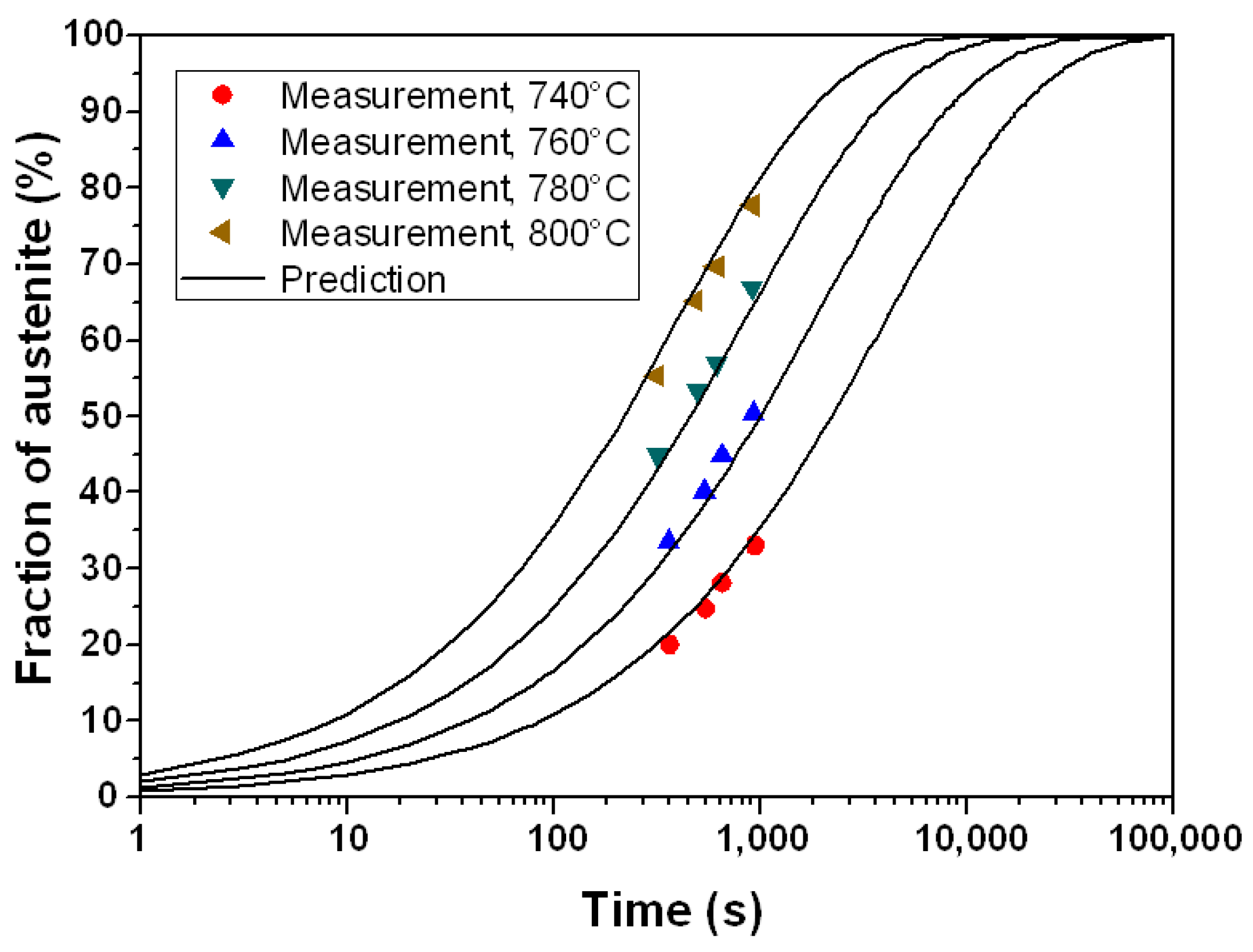
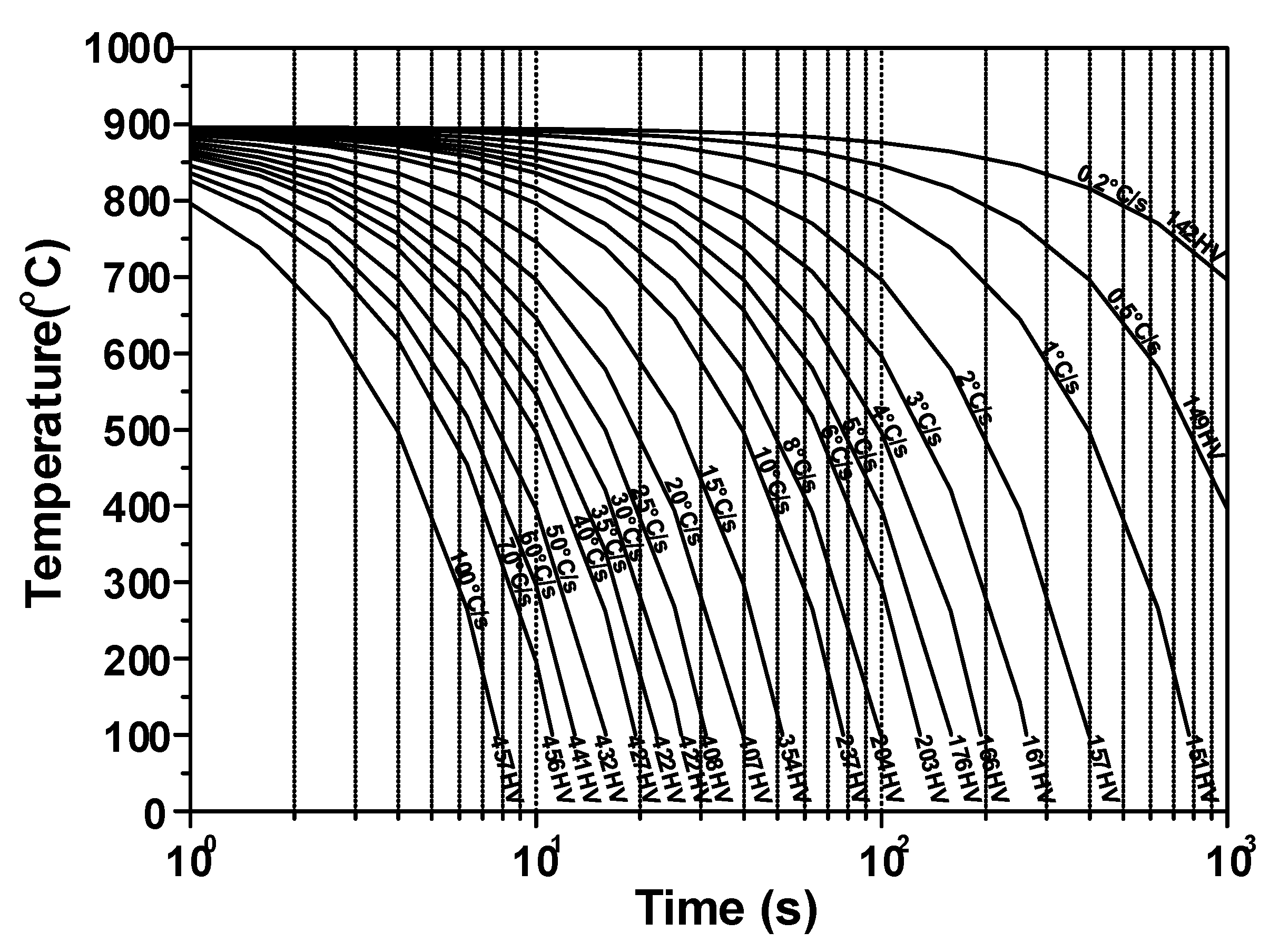
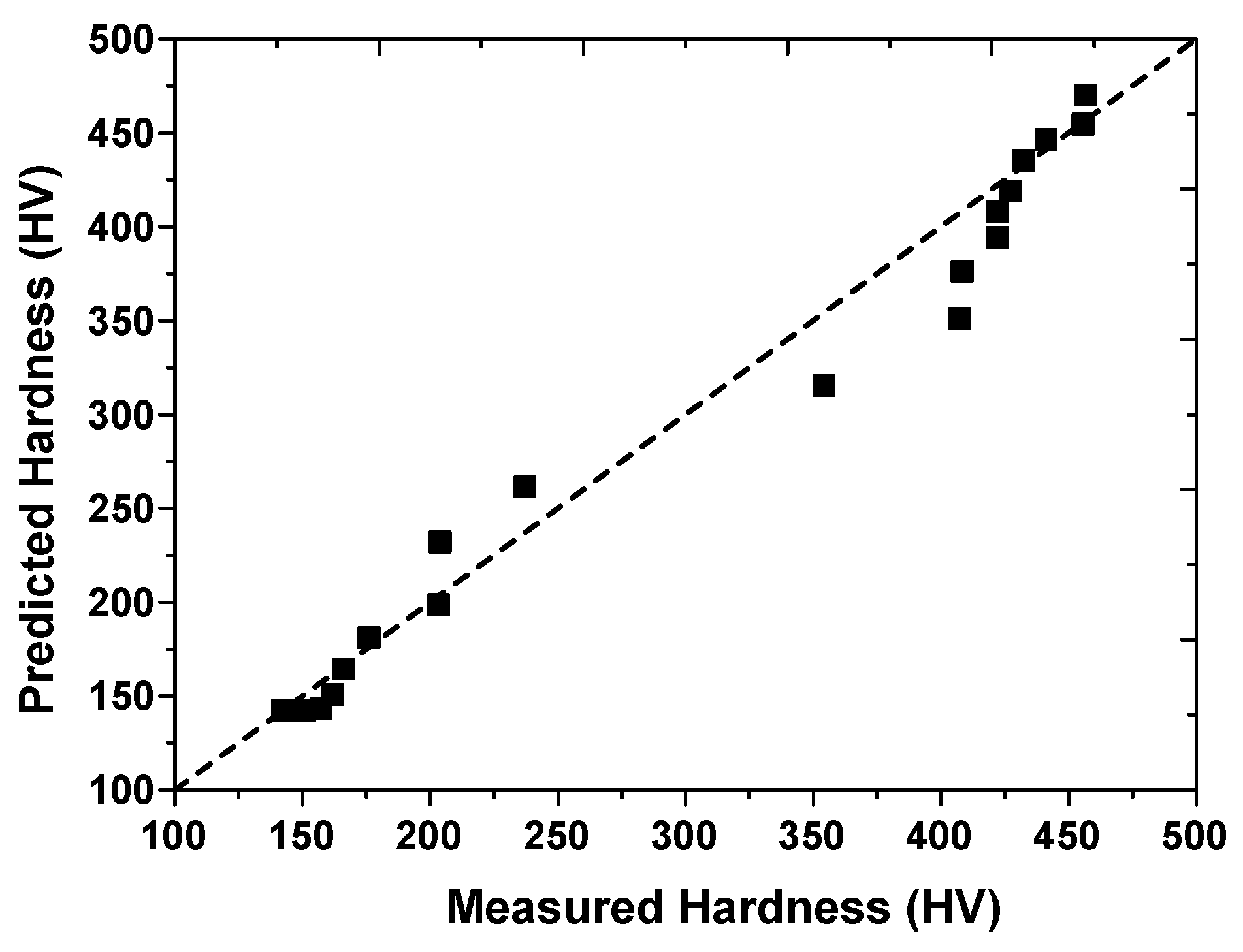
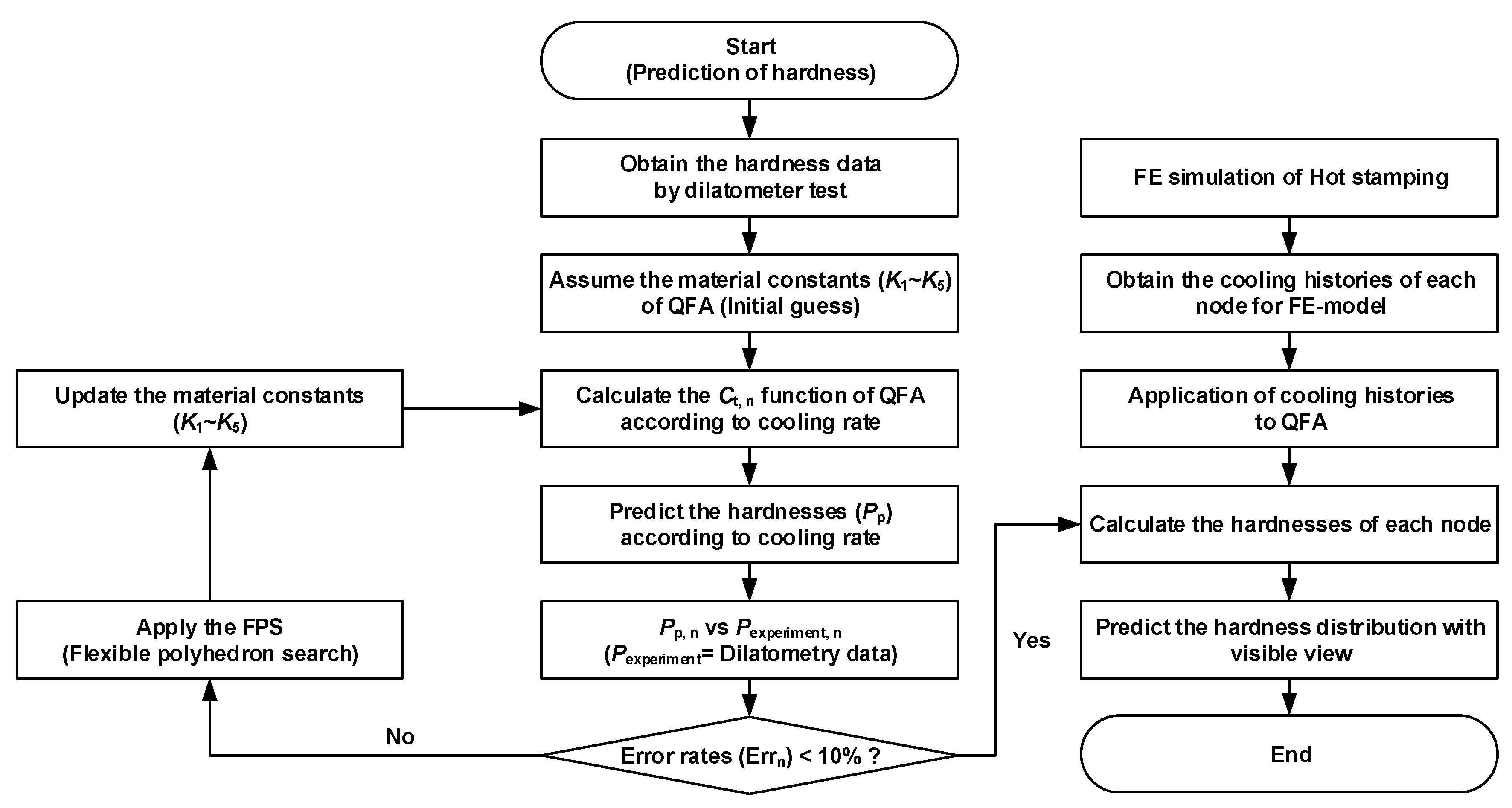
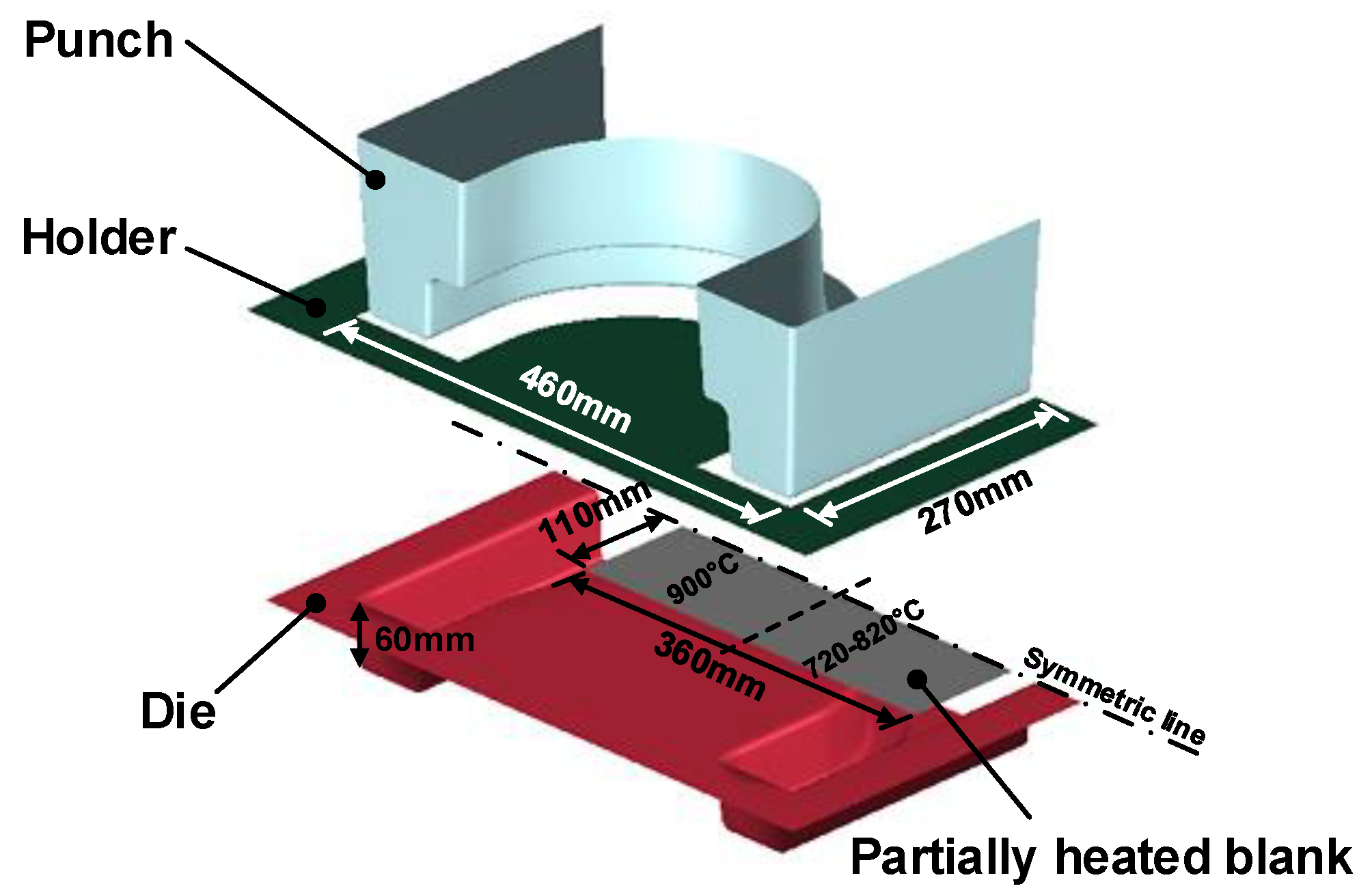
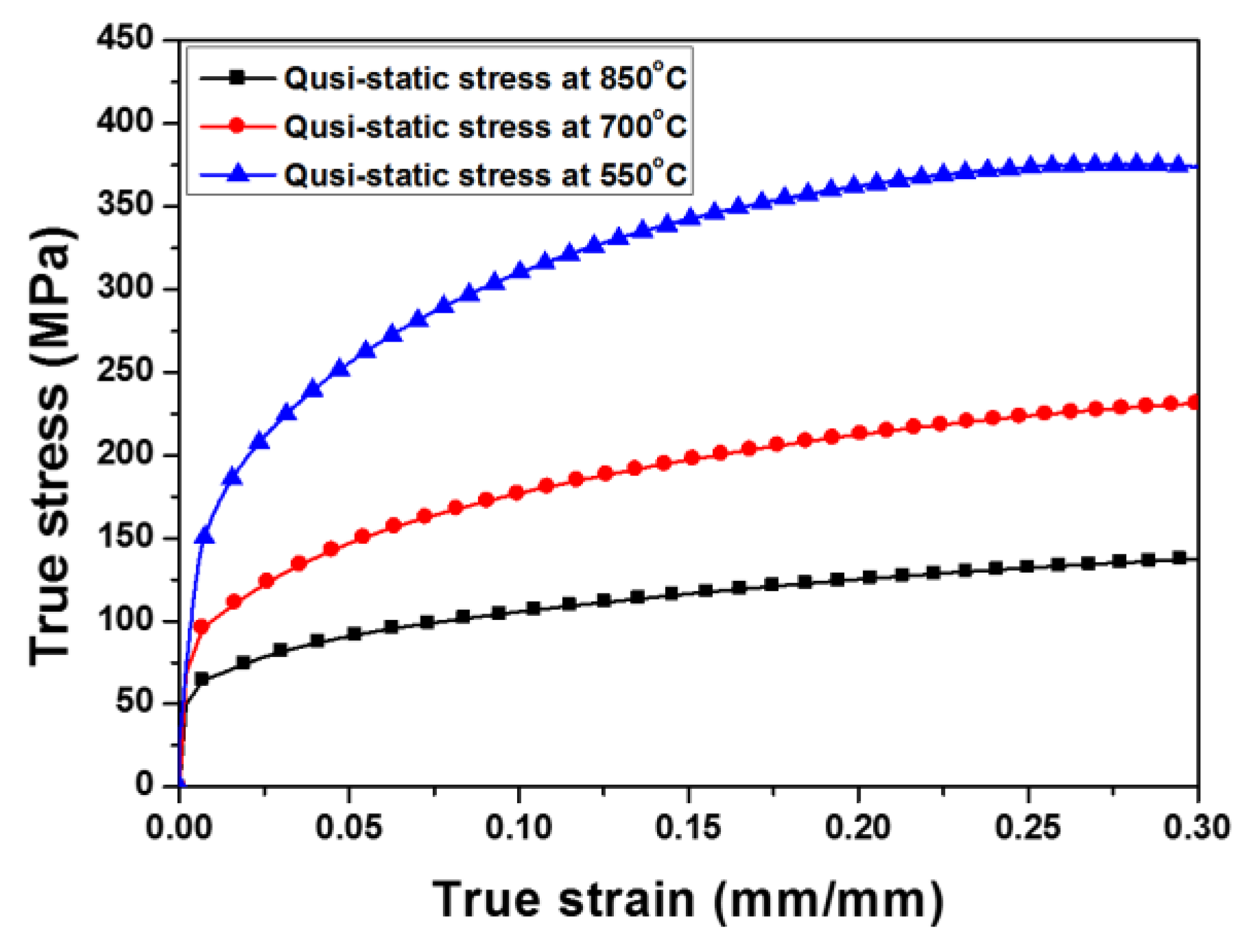

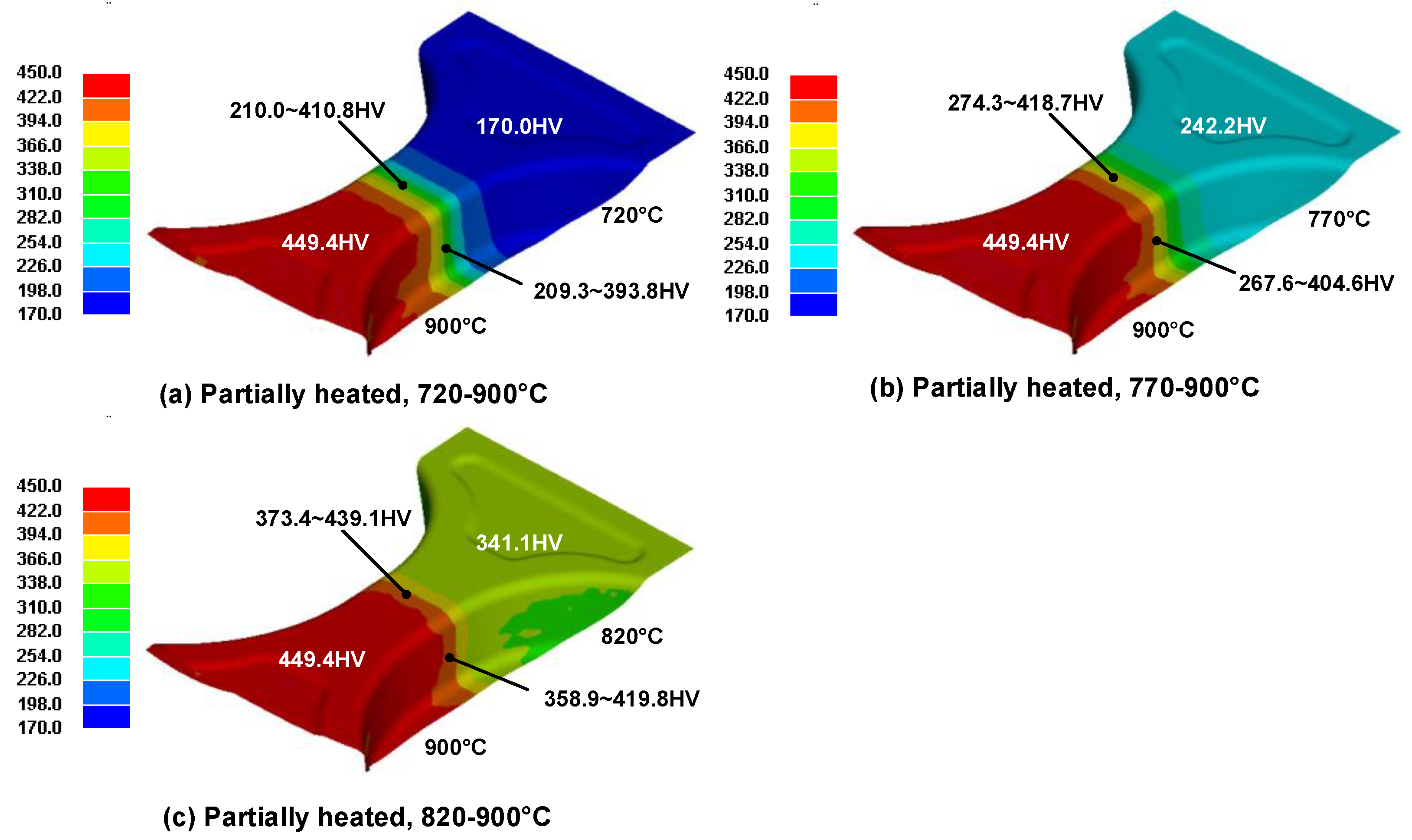
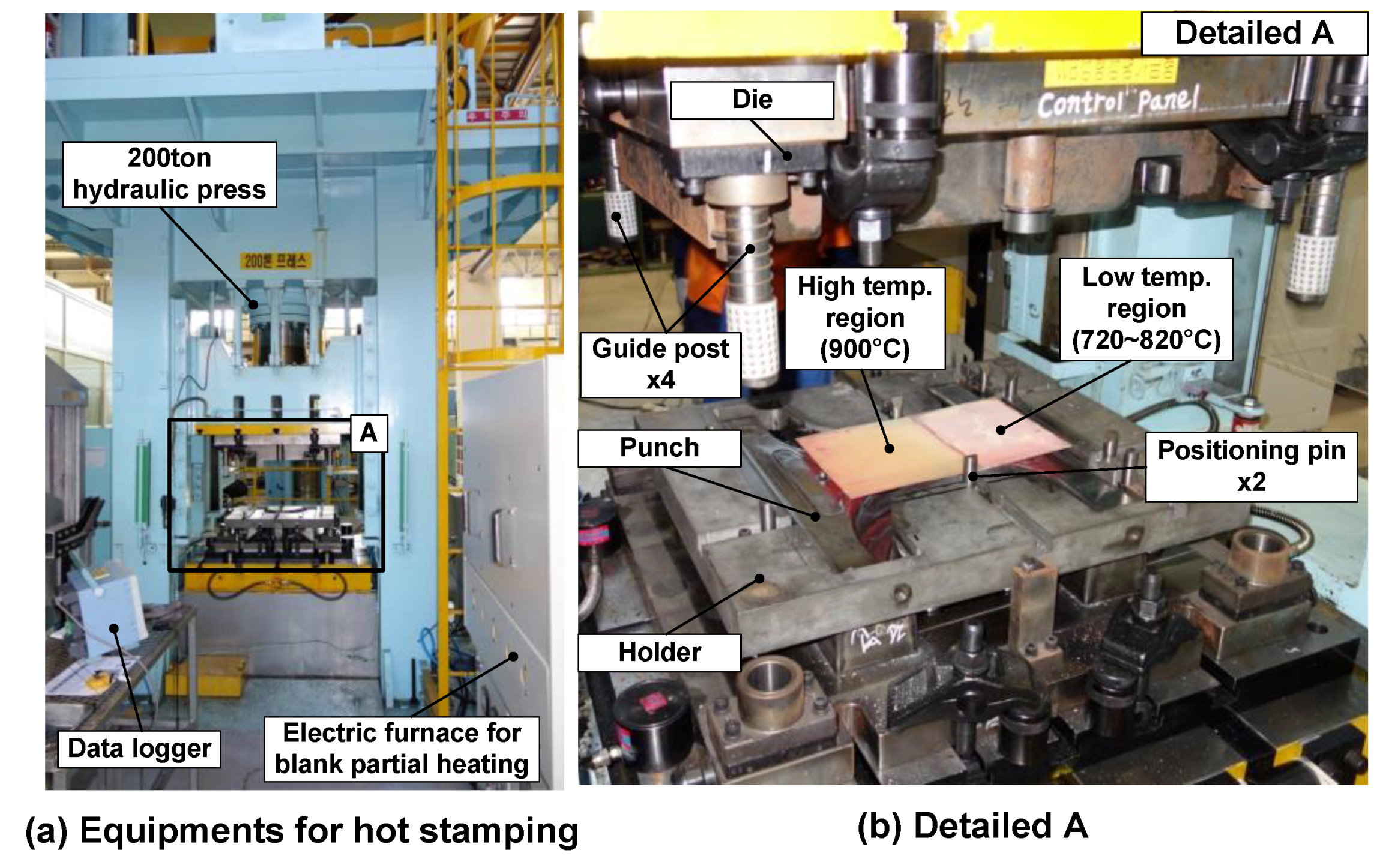
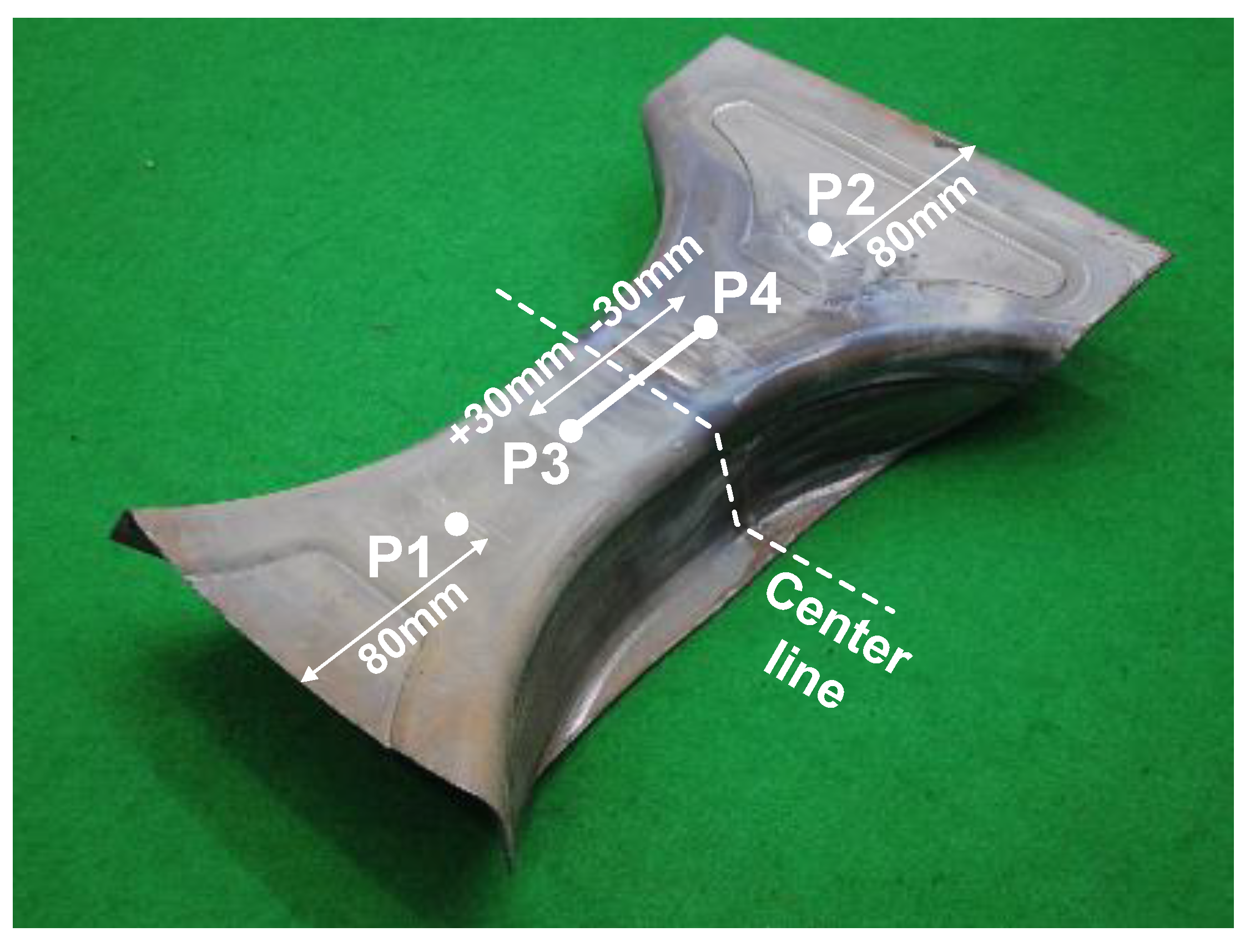


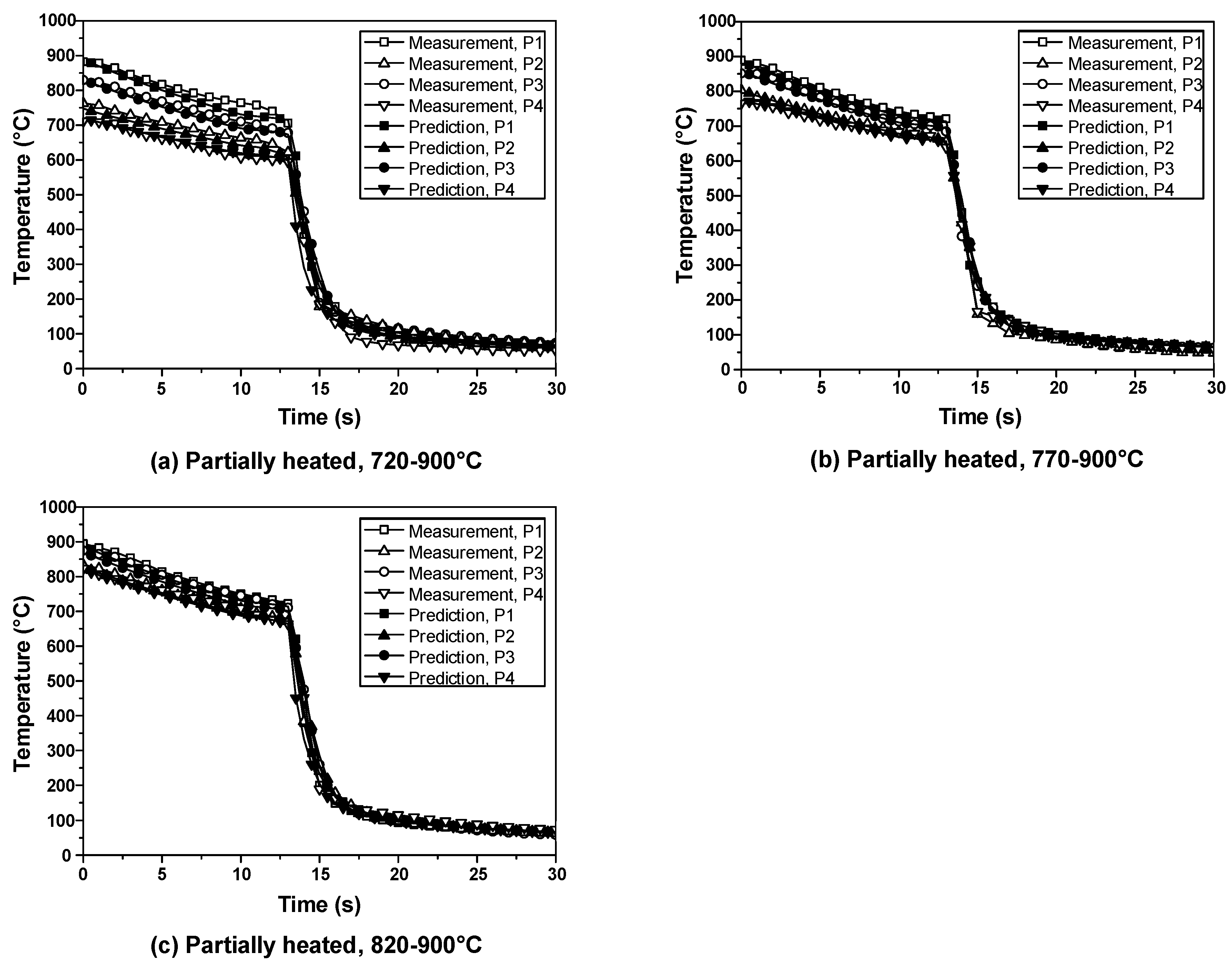

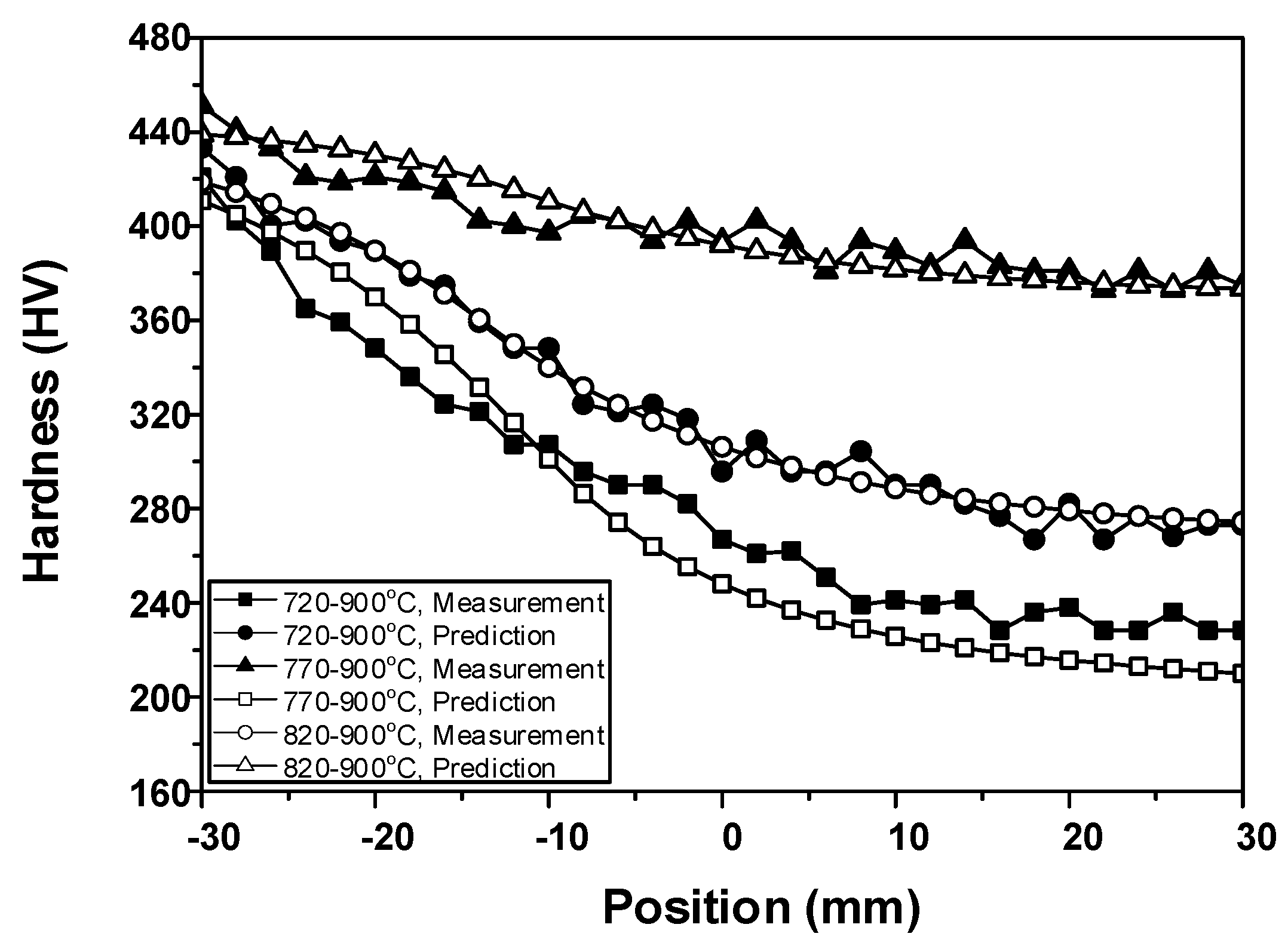
| Material | Chemical Compositions (wt.%) | |||||||
|---|---|---|---|---|---|---|---|---|
| Boron Steel | C | Si | Mn | Cr | Al | Ti | B | Fe |
| 0.220 | 0.260 | 1.180 | 0.148 | 0.057 | 0.028 | 0.003 | Bal. | |
| n | A | E (J/mol) |
|---|---|---|
| 0.58 | 2.19 × 108 | 202.47 × 103 |
| K1 | K2 | K3 (J/mol) | K4 (K) | K5 (J/mol) | Pmax (HV) | Pmin (HV) | Pi (HV) |
|---|---|---|---|---|---|---|---|
| −0.00501 | 0.0494 | 331.32 | 1173 | 40000 | 509 | 142 | 170 |
| Material Constants | Temperature (°C) | ||
|---|---|---|---|
| 850 | 700 | 550 | |
| C | 55.38 | 65.26 | 80.54 |
| p | 3.7 | 3.84 | 3.89 |
| Conditions | Values |
|---|---|
| Young’s modulus (GPa) | As a function of pressure [3] |
| Poisson’s ratio | 0.3 |
| Thermal expansion (1/K) | 1.44 × 10−5 |
| Heat conductivity (W/m·K) | 32 |
| Convective heat transfer coefficient (W/m2·K) | 20 |
| Interfacial heat transfer coefficient (W/m2·K) | As a function of pressure [3] |
| Friction coefficient (μ) | 0.4 [15] |
© 2018 by the authors. Licensee MDPI, Basel, Switzerland. This article is an open access article distributed under the terms and conditions of the Creative Commons Attribution (CC BY) license (http://creativecommons.org/licenses/by/4.0/).
Share and Cite
Kim, J.-H.; Ko, D.-C.; Lee, S.-B.; Kim, B.-M. Hardness Prediction in Hot Stamping Process by Local Blank Heating Based on Quench Factor Analysis. Metals 2019, 9, 29. https://doi.org/10.3390/met9010029
Kim J-H, Ko D-C, Lee S-B, Kim B-M. Hardness Prediction in Hot Stamping Process by Local Blank Heating Based on Quench Factor Analysis. Metals. 2019; 9(1):29. https://doi.org/10.3390/met9010029
Chicago/Turabian StyleKim, Jae-Hong, Dae-Cheol Ko, Seon-Bong Lee, and Byung-Min Kim. 2019. "Hardness Prediction in Hot Stamping Process by Local Blank Heating Based on Quench Factor Analysis" Metals 9, no. 1: 29. https://doi.org/10.3390/met9010029






